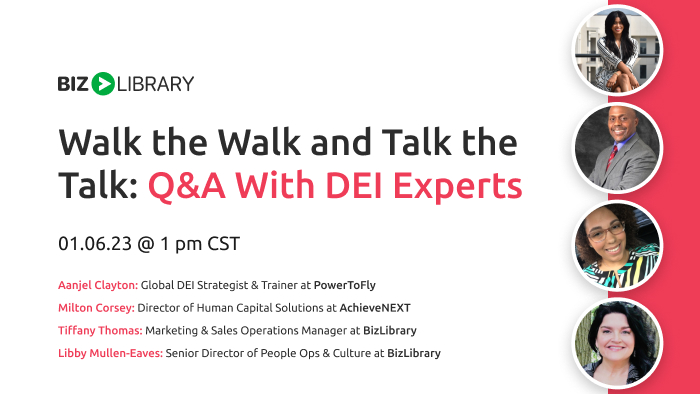DEI. Diversity, equity, and inclusion. These are important words in any workplace that fold into helping create a supportive environment for all workers.
Creating DEI in the workplace goes beyond establishing policies at the top and requires that everyone understands exactly what it is and how to apply the principles in their daily lives. To see the best results, D&I training should be spread over an extended period of time, and not just a once-a-year occurrence. That’s where training comes in.
A well-planned strategy full of the right DEI course content will make training employees successful. So, what topics should your program cover?
Meaning of Diversity, Equity, and Inclusion
Clarify what each of these terms mean as some may not realize they are different.
Diversity refers to the presence of differences within an environment, so in the workplace it could be different gender identities, sexual orientations, races, ethnicities, ages, as well as socioeconomic class, veteran status, and differences in physical ability.
Equity is the process of ensuring that workplace practices and programs are impartial, fair, and provide equal possible outcomes for everyone.
Inclusion is the practice of ensuring that people feel a sense of belonging in the workplace, meaning that every employee feels comfortable and supported by the organization and feel like they can be their authentic selves.
Stereotypes, Unconscious Bias, Prejudice, and Microaggressions
These four categories are closely linked, and again, it’ll be important to train the entire organization on them.
First let’s look at stereotypes. Stereotyping in the workplace is making assumptions about people based on their gender, religion, age, physical attributes such as skin color, sexual orientation, or culture. These beliefs don’t easily disappear from the collective consciousness and often persist for long periods of time. A great example of stereotypes perpetrated today in the workplace: the generational gap in the workplace.
Oftentimes younger generations criticize older employees as being out of touch or technologically challenged while the younger generations are criticized for being self-indulgent and ungrateful.
Next let’s look at unconscious bias. Unconscious biases manifest in many ways and arise from judging people’s appearances, preconceived notions, and even logical fallacies. Here are some different types of unconscious bias:
- Gender bias is the favoring of one gender over another and plays into sexism. This bias occurs when someone unconsciously associates certain stereotypes with different genders.
- Name bias refers to often preferring certain names over others and associating names with certain cultures. This is most prevalent in recruitment.
- The Halo effect happens when someone has a positive impression of someone because of a specific characteristic – where they graduated college, where they grew up, etc.
- The Horns effect is the opposite of the Halo effect and happens when someone has a negative impression because of a certain characteristic of a person.
- Conformation bias occurs when someone has a preconceived notion about a person and searches for information to solidify that belief.
- Conformity bias is when someone will change their beliefs to match that of a bigger group to fit in. This could also fall under peer pressure.
Next, let’s look at prejudice. Prejudice is simply having a preconceived opinion that is not based on and reason or experience.
Lastly, it’s important to look at microaggressions. These are perhaps the most prevalent discrimination that happens in the workplace. They are rather subtle, often unintentional interactions or behaviors that communicate bias toward marginalized groups that people. Here are some examples of microaggressions:
- Asking to touch someone’s hair
- Asking someone where they are from
- Giving someone a nickname that is easier for you personally
- Mistaking a person of color for a more service-oriented position
- Creating an ableist environment
Bystander Intervention
While it’s great for employees to know the ins and outs of DEI, it does no good if they don’t know how to report any violations they may see at work.
Employees need to know why confronting discrimination is important, the barriers that can happen when confronting discrimination, and how to confront discrimination effectively.
Strategies an employee can use are:
- Delegate: This transpires when an employee tries to stop any harassing behavior by seeking help from others, whether it be other bystanders or a manager.
- Distract: Distracting means that an employee might talk to either the perpetrator or target of harassment about something else to interrupt the harassing behavior without antagonizing either party.
- Direct: Direct involvement occurs when a bystander either directly responds to the harasser to tell them to stop or to the target and asks if they need help.
Understanding when to use this strategy should be outlined in any bystander intervention training, as the training should be meant to empower, not compel, bystanders to intervene.
Organizational Policies and Other Trainings
Perhaps you have organization-specific trainings regarding DEI. Those should be included in your content training. You can customize training to suit your company and industry.
Additional Trainings
There are other training topics to include in your DEI strategy.
- Inclusive Leadership – For individual contributors to take training seriously, they need to see that their leaders are as well. That’s why it’s important to have DEI training specifically for leaders. Renown leadership expert and founder and CEO of Work Meaningful, Justin Jones-Fosu, has an entire series on an Inclusive Mindset in our content library. He discusses what diversity is and isn’t, paints a picture of what an inclusive mindset looks like, defines the circles of grace model, and showcases the importance of listening to learn about others’ experiences, all things that help managers become intentionally inclusive leaders.
- Becoming an Ally – An ally is any person who is actively promoting and striving to advance a culture of inclusion through their actions to benefit people as a whole. To be a true ally, people should:
- Lift others up by advocating for them
- Share any growth opportunities with others
- Recognize systematic inequalities
- Believe the stories and experiences of underrepresented people
- Listen to others while offering support. Then spend some time in reflection and change any negative behaviors.
Building a Culture of Inclusivity
A strong DEI initiative includes more than just content to watch and review occasionally. You’ll need to make it an interactive, year-around process to help build a culture of inclusivity.
Project Kickoffs
By nature, vulnerability is a scary thing. Opening ourselves up for others to see our true selves can be anxiety-inducing. That’s why creating a safe space for vulnerability in the workplace is so important.
One way to promote authentic, vulnerable conversations within a team is to kick off new projects with introductions. It could include each person saying their name, their pronouns, and one word to describe themselves and why they chose it.
This helps establish trust by communicating vital personal facts and allows employees to learn about one another in a safe, respectful way.
Roundtable Discussions
A great way to build an understanding of each of our differences is to hold panels and round table discussions that talk about different cultural experiences. They could be TedTalk-like, lunch and learns, etc. and will educate employees on the background, meaning, and importance different cultures. By explaining some cultural context and history, a workplace can become more inclusive and culturally conscious.
ERG Groups
It’s important for employees to feel like they belong and have safe spaces to come together and network with one another. A great way to foster this is through employee resource groups (ERGs). These groups allow for people with similar interests and backgrounds to come together, talk to each other, plan events, etc.
DEI is vital to creating and maintaining a successful workplace where every employee can thrive personally and professionally and be their authentic selves. It’s important as managers and leaders to grow in their knowledge and find new and interesting ways to talk about DEI.

